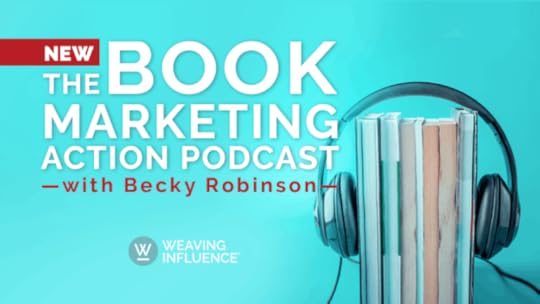Becky Robinson's Blog, page 23
February 25, 2020
Episode 3: The Building Phase

Click here to listen on your device and subscribe!
Welcome to The Book Marketing Action Podcast with Becky Robinson! Becky is the founder and CEO of Weaving Influence, a digital marketing agency that specializes in marketing books and connecting leadership and business professionals with ever-growing networks.
There are 4 phases of your book marketing journey. In today’s episode, Becky talks in depth about the building phase. The 4 phases are:
Building (6 months prior to launching)
Working (4 months prior to launching)
Launching (week of your publication date)
Advancing (1-month and beyond post-launch)
There are 3 priorities in the building phase.
Build content related to your book on your social media platforms.
Build connections on social media.
Build contacts through a permission-based email list.
If you are currently in the building phase of marketing your book, ask yourself: “Am I doing a good job at balancing the writing priority to finish my book with the marketing priority of building a platform?”
If you answered yes, congratulations!
If not, your next step is to think about what sustainable marketing approaches you can implement when you finish writing your book.
Think about the three priorities of the building phase. What one or two activities can you do this week to help you build in those three areas?
Share your thoughts below or email Becky Robinson here.
Click to share this episode on Twitter.
The post Episode 3: The Building Phase appeared first on Weaving Influence.
Episode 2: What Is Your Why? & The 4 Phases of Book Marketing

Click here to listen on your device and subscribe!
Welcome to The Book Marketing Action Podcast with Becky Robinson! Becky is the founder and CEO of Weaving Influence, a digital marketing agency that specializes in marketing books and connecting leadership and business professionals with ever-growing networks.
In this episode, Becky talks about the 4 phases of marketing your book.
Building (6 months prior to launching)
Working (4 months prior to launching)
Launching (week of your publication date)
Advancing (1-month and beyond post-launch)
No matter what phase you are currently in, identify the why behind your desire for wanting to market your book. Your main goal for marketing your book should be bigger than book sales. Do you want to grow a business? Or maybe you want to position yourself to become a speaker.
Ask yourself these two questions to identify your why:
Why did you write your book?
What is the job you want your book to do for you in the world?
Let us know what phase of your book marketing journey you are currently in and your why behind marketing your book. You can comment below or email Becky Robinson here.
In this episode, we mention our Book Marketing Action Guide. The guide is a comprehensive 4-phase course that is designed to help authors build their platforms, launch or re-launch their books, and get their books to their intended audiences.
Click to share this episode on Twitter!
The post Episode 2: What Is Your Why? & The 4 Phases of Book Marketing appeared first on Weaving Influence.
February 24, 2020
Episode 1: An Introduction

Click here to listen on your device and subscribe!
Welcome to The Book Marketing Action Podcast with Becky Robinson! Becky is the founder and CEO of Weaving Influence, a digital marketing agency that specializes in marketing books and connecting leadership and business professionals with ever-growing networks.
The vision for this podcast is for Becky to share what she has learned in the 8 years of business book launches and what she continues to learn daily. At the end of every episode, Becky will share actions you can implement to reach a wider audience with your book and message.
We want to be your guide in focusing on the actions that will make the biggest differences for you over time.
In addition to our podcast, we offer a signature course on our website called The Book Marketing Action Guide. The guide is a comprehensive 4-phase course that is designed to help authors build their platforms, launch or re-launch their books, and get their books to their intended audiences.
Questions? Reach out to us below or send us an email here.
Click to share this on Twitter!
The post Episode 1: An Introduction appeared first on Weaving Influence.
February 20, 2020
The Book Marketing Action Podcast

We’re excited to announce that we are launching a podcast! It’s called The Book Marketing Action Podcast, and as you can probably guess from the title, it’s going to be about all things book marketing.
You might be wondering why we’re starting this podcast when we already have The Book Marketing Action Guide and other free resources at your disposal. Well, our goal is to share some of what we’ve learned—and are still learning—about book marketing. The most important thing we’ve learned through 8 years of business book launches is that there is no magic formula to increase awareness and sales . . . there’s only focused, consistent effort over time that makes a difference.
For this reason, our podcast is focused on ACTION. At the end of every episode, we’ll share one or more actions you can implement to reach more people with your book and message. If you implement these actions consistently over time, you’ll see results. Some of these actions will seem easy, and others will be more challenging. We want to be your guide in focusing on the actions that will make the biggest difference for you over time and help move your goals forward.
Occasionally, we’ll invite authors to share their best marketing tips and success stories with you; but mostly, our CEO and founder, Becky Robinson, will be that voice of encouragement and inspiration in your ear, telling you to keep going.
We hope you’ll give us a listen and ask questions along the way. We love to support authors on their book marketing journey, and we can’t wait to answer your questions, provide guidance, and recommend weekly to-dos no matter where you are in your marketing journey.
The podcast will launch weekly on Tuesdays, with the first episode going live on February 25th. These episodes will be short enough to listen during your morning commute, at the coffee shop, or while you get ready in the morning, so we hope you’ll join us.
If you have any questions that you’d like us to address on the podcast, please email them to becky@weavinginfluence.com.
The post The Book Marketing Action Podcast appeared first on Weaving Influence.
February 18, 2020
We DO Judge a Book by Its Cover

We’ve all heard you should never judge a book by its cover, but the reality is we do—and readers do. Authors spend months and sometimes years writing their books, but just minutes making decisions about how the book looks and feels.
The visual elements of a book creation may seem to be less important than the content, but a strong title or a powerful cover can actually be the difference between strong sales and the remainder table.
It’s critical to spend time on the decisions around how your book looks and feels. These design elements can have as much impact as your great content! Here are six areas to pay attention to before publishing your next book.
Book Title
Publishers have expertise around what language drives purchase—knowledge that authors may not possess. The more collaborative the title work is, the more likely you are to land on a real winner.
We suggest authors, in conjunction with their publishers and marketing partners, come up with several titles and subtitles, then ask their perspective readers for input. This can be gathered via an email survey or by requesting input on social media. You’ll often be surprised what moves readers to buy books. It’s worth hearing from them.
Keep in mind that your book is aimed at a very specific audience. The title needs to resonate with the intended audience, not just with you.
Cover Design
We’ve seen many terrific books fail to reach their potential because of poor cover design. We really do judge a book by its cover—so make sure yours is a standout!
Do some research in your category to understand current best selling colors, styles, and imagery. The wrong font can make a brand new book look dated and old.
Research what successful covers in your category look like, and check out books that aren’t selling well to see how their covers differ.
Get feedback. Just because you love a color doesn’t mean others will. You want a cover that works!
Book Description
The title and cover will lure the readers in, but the book blurb (on the back cover or inside the dust jacket) should really hook them.
Make sure this short description accurately captures the power and value of your work. It should clearly indicate who will benefit from the book, what questions it answers or solves, and what makes you qualified to write on the topic.
Descriptions should speak directly to your target audience, and succinctly and powerfully give them reasons to buy and read your book.
Quality Endorsements
Authors often leave the decisions about title and cover design to the last minute, and rush through them while they stress over endorsements. We’re here to tell you endorsements matter—but unless you have an “Oprah” sticker on your book, those endorsements have little impact on sales.
Switch your priorities. Spend more time and energy coming up with a title and cover that will rock the world of your audience, and less time on endorsements.
Quality matters more than quantity. Three rock solid endorsements mean more than twenty from CEOs whose names readers don’t recognize.
Internal Formatting
How your book looks on the page is important, and authors can and should give thought to these decisions.
Fonts that look dated or distracting can actually hurt your book, no matter how good your message may be. Take, for example, Comic Sans. Now, we don’t expect any publishing companies will recommend this font—but there are others that may be less dramatic which can still make your book clumsy to read or appear dated and old. Fonts matter!
Page formatting matters, too. We’ve all picked up a book with tiny print, small margins, and few spaces—and those are books we normally then put right back down. Make sure your formatting is easy on the eyes and comfortably readable.
Copy Editing
This is the area where many self-published books fall flat! If you have mistakes in your book—spelling issues, grammar issues, or factual errors—readers will notice. Most readers are generally kind people, so they will forgive maybe one error . . . but much more than that, and you begin to lose their trust. Don’t skimp on quality copy editing!
Content is only the beginning of a successful book launch. Design can have a powerful impact!
Getting feedback and expert help can make the process easier for the author, and ultimately, more successful for the book.
The post We DO Judge a Book by Its Cover appeared first on Weaving Influence.
February 11, 2020
Goodreads: A Key Author Tool

When we ask new clients if they have a personal account on Goodreads, we are often met with blank looks. Goodreads? What’s that?
If you’re having the same reaction right now, then grab a cup of coffee and keep reading—because if you’re an author and you’re not using Goodreads, you’re missing out on a key tool in your marketing box!
The Basics
If you’re not even sure what Goodreads is, then let’s start there. Goodreads is social cataloging website that allows authors and readers to keep track of what they’re reading, find recommendations for what to read, collect quotes, participate in group discussions, and more. To summarize, Goodreads is low-commitment social media for bookworms. Launched into the online world in January 2007, sold to Amazon in 2013, and reported to have more than 90 million members as of July 2019, Goodreads is a readers’ resource.
How To Use It
That depends on whether you are a reader-only, an author, editor, or illustrator. In addition to my official page that links to my work as an editor, I personally use Goodreads to keep track of every book I read, discover new authors and books that interest me, and write reviews (which are conveniently linked to Amazon through Kindle—so I finish an ebook, immediately write an Amazon review, and it also publishes on Goodreads).
Most authors already have a page on Goodreads, they just don’t realize it and haven’t taken ownership of it yet. If your book has been listed on the site by your publisher, publicist, or a member of the reading public (like your launch team), then your name is automatically linked to that book… and maybe a whole lot more.
By claiming your official author page, you are able to link yourself (with the help of Goodreads or one of their librarians) to the books you’ve written, optimize your page to include a current bio and headshot, upload book trailers, link to your Twitter account and blog or website, and add quotes from your book(s) for others to find and share. Think of it as free publicity!
Why It Matters
I have lost track of the number of times I have searched Google for a quote, an author, or a book title and the top result is from Goodreads. It’s even better when the top result takes me to a page or a quote for an author whose page I have assisted in optimizing, because it means it’s working.
Once the initial set up is done, Goodreads requires very little time. You might find that you like being able to catalogue your current reads, or you might find that you only log on once or twice a year to make sure everything’s still up to date. Either way, if you’re not utilizing this resource, you’re missing out on search results, connecting with readers who are looking for books in your specific genre, and the opportunity to reach a wider audience for your book.
For information about how to get started as a verified author on Goodreads, visit: https://www.goodreads.com/author/program.
The post Goodreads: A Key Author Tool appeared first on Weaving Influence.
February 4, 2020
Why Amazon Reviews Matter

How many of you have ever purchased—or not purchased—a book because of a review you read? I’ll be the first to admit that many of the books currently on my nightstand, waiting to be read, are there because of an Amazon or Goodreads review. Although I occasionally add a book to my list because a blogger I respect speaks highly of it, most of my purchases are a direct result of the feedback of others after they’ve read the book.
If you’ve ever been a part of any book launch team, I’m sure you’ve been on the receiving end of pleas for launch week reviews, post-launch reviews, and anniversary reviews. If you’ve ever wondered why they matter, go back up and read that first paragraph again.
Reviews = sales
If you received your copy for free because you joined the launch team, one of the best ways to repay the author is by leaving a review on Amazon. Maybe you didn’t buy the book, but your honest review may very well be the deciding factor in someone else purchasing it.
More reviews = more clout
When I look at review numbers and see fewer than ten, I’m skeptical about the value of the book, and reconsider making a purchase. However, if I see more than 50 or anything in the 3-digit realm, it causes me to pause and start reading what other people have written about it. If 75 people gave this book a 4 star rating, or higher, maybe I should check it out.
Honest reviews = greater trust
Over the years, I’ve worked with authors who were upset when anyone left anything lower than a five star review. What I’ve tried to express—not only as a book launch consultant, but as bookworm—is that well written, honest 3- and 4-star reviews often sway me more than the clearly biased 5-star write-ups. I have plenty of 3-star books on my shelf, and a lower review doesn’t make them bad, they’re just not up to my view of what constitutes a 5-star rating.
So if you’re sitting there with a pile of books that you’ve read and you’re wondering whether or not you should go leave a review on Amazon (and Goodreads), the answer is a resounding YES.
But before you go, here are a few tips to keep in mind…
If you haven’t actually read the book, don’t leave a review. If it’s a friend’s book, don’t write something about how it’s a “must read” when you skimmed it out of obligation.
If you didn’t love it, don’t leave a 5-star review. Be honest, because review readers will be more apt to take your honest review into consideration when making a decision to purchase. That being said…
There’s no reason to write a critical review of a book you received for free. You can write a 3-star review, but make sure you give valid reasons for the lower rating, and spend most of your time focusing on what you did find helpful or enjoyable.
You may not be able to review it. This is especially true if you received it for free from a friend or family member. Amazon’s guidelines about who can and cannot leave reviews are pretty clear on this, and they’ve been cracking down on this in the last couple of years.
It’s never too late to leave a review. Even if you don’t get around to reading a book until 6 months or a year after the launch, go ahead and write something for that book you got two years ago and finally finished. Not only will it make the author’s day to see a new review pop up, it will tell potential buyers like me that people are still reading it.
A Note to Authors: If you’ve shipped out books and sent follow up but are still not seeing as many reviews as you would like, don’t hold it against your tribe. Life happens, people are busy, and not every book is a homerun with everyone. Exercise grace, and don’t take it personally when those positive 3-star reviews come in… it may still make someone like me click “buy now.”
The post Why Amazon Reviews Matter appeared first on Weaving Influence.
January 28, 2020
Amazon Rankings Explained

Writing a book takes a tremendous amount of time and dedication. Once that book is released to the world, it’s every author’s hope that it will be well received by readers, and make a best seller list.
While we don’t discourage our authors from aiming for a list, we do suggest reframing those goals to become an Amazon best seller instead.
Level the Playing Field
Here’s why: best seller lists are rarely an accurate and impartial reflection of book sales, and often the requirements are stacked against non-fiction leadership books.
The New York Times lists requires at least 10,000 pre-orders through specific retailers to even be considered, the Wall Street Journal requires 3-5,000 book sales in a week, and the USA Today list groups all book sales together so business/leadership books are up against the latest John Grisham novel.
In addition, all the lists tend to ignore bulk sales, limit the success of self-published or non-traditional books, and under-count ebook sales.
Amazon has a much more level playing field. Rankings are based on sales from hour to hour. The Amazon algorithm is also part of the best seller equation, and while how that algorithm works is not transparent, it doesn’t seem to favor any type of books. Ebooks, self-published, and non-traditionally published books all seem to get fair consideration.
Rise to the Top
While there are no firm sales numbers required to make an Amazon list, the rough estimate is that it takes approximately 500 sales in one day to crack the Top 100, and 2,000 sales in a day to make the Top 10. To increase the odds of having a Top 100 designation, we encourage our authors to focus marketing efforts around launch day.
For some niche titles, hitting the Top 100 isn’t feasible—but being in the top of a category is, which is why choosing sub-categories for a book is so important. For the greatest success, we recommend getting very specific with your book’s categories.
Selling just 10-20 books in the right category can propel a title into the Top 10 and trigger a Best New Release banner—but don’t think you can just buy 20 of your books and hit the jackpot. Amazon only credits two book purchases per IP address.
What is Your Goal?
A best-seller designation is a great start, and can be leveraged in future marketing efforts—but a list designation alone will not sell books. Making a best seller list is a great ego boost, but selling books for years to come is a great career and financial boost. Which one are you after?
The post Amazon Rankings Explained appeared first on Weaving Influence.
January 24, 2020
Female Firebrands

Have you learned how to recognize the role of privilege at work and how it can be used for positive change? Do you understand what it means to be an informed, empowered advocate for women?
This week’s featured book provides wisdom and advice to help you develop tools and techniques to stand and speak up on behalf of yourself and others, when it’s both difficult and necessary. It shares how to get better at recognizing ”little indignities” you don’t have to tolerate, and how to increase awareness of your own blind spots and biases so you can learn from them.
Female Firebrands
Women of all generations will nod in recognition at the stories of thirteen professional women from diverse backgrounds and industries as they recount the career challenges they’ve faced and how they have overcome bias, sexism, and the power imbalance. If you’ve ever wondered what a true firebrand is, you’ll find out in Mikaela Kiner’s powerful first book.
Full of practical examples and valuable insights and techniques, Female Firebrands is an honest, modern, and solutions-oriented guide for dealing with situations working women know all too well: sexual harassment, not being taken seriously, and being talked over, passed over, underpaid, and under-appreciated.
Just like millions of other women who are trying to navigate the workplace every day, the firebrands are whole people, dealing with work, family, balance, confidence, and the need to stay motivated and strong. These role models stand out from the crowd with their inspirational stories, not just because they’ve been successful in their careers, but also because they’re mission driven, doing good in the world, and making a difference for all women.
Female Firebrands is an honest, modern, and solutions-oriented guide for dealing with situations women know all too well: sexual harassment, not being taken seriously, and being talked over, passed over, underpaid, and underappreciated. Mid-career professional women will read this book and know they’re not alone—and women earlier in their careers can save years of heartache and frustration by learning what’s worked for women who came before them.
Meet the Author
 Mikaela Kiner has an MS in Human Resources Management, is a certified executive coach, and is an experienced consultant. In 2015, Mikaela founded Reverb, a leading provider of innovative HR services for startups and growing companies in the Pacific Northwest. An HR leader for nearly twenty years, Kiner enjoys coaching leaders at all levels and helping companies build healthy, inclusive cultures. She’s been quoted in Fast Company, The Wall Street Journal, and The Muse and is a member of the Forbes Human Resources Council. Mikaela is married to Henry, a musician, artist, and teacher. Their two children, Simon and Sidonie, are good at challenging the status quo and are a constant source of learning and laughter. She lives with her family in Seattle.
Mikaela Kiner has an MS in Human Resources Management, is a certified executive coach, and is an experienced consultant. In 2015, Mikaela founded Reverb, a leading provider of innovative HR services for startups and growing companies in the Pacific Northwest. An HR leader for nearly twenty years, Kiner enjoys coaching leaders at all levels and helping companies build healthy, inclusive cultures. She’s been quoted in Fast Company, The Wall Street Journal, and The Muse and is a member of the Forbes Human Resources Council. Mikaela is married to Henry, a musician, artist, and teacher. Their two children, Simon and Sidonie, are good at challenging the status quo and are a constant source of learning and laughter. She lives with her family in Seattle.
Praise from Readers Like You
“I loved this book, both for the stories that resonated and for the really useful techniques and tips for not just women but anyone today who aspires to be better in the workplace and in the world. The format was fabulous, introducing a set of powerful “firebrand” women with unique and ubiquitous stories and then launch straight into gritty conversations on privilege, #MeToo and a challenge to be honest about our own biases even and especially amongst women. I was left with both a sense that I am understood and ideas and tools to prepare for the inevitable opportunity where I step up to be a better ally for others or myself. “ —Janelle Aberle, 5-star Amazon review
“This book has been a fantastic read, it’s like you’re sitting down to coffee chats, or attending panel presentations, as you take in all the relatable stories and great advice. I finished the book in a matter of days, but I find myself coming back to it for additional wisdom when I need it. I especially love the ‘end-of-chapter checklist’ targeted to various audiences. In my opinion, this is a must-have for your female empowerment library!” —Adrienne, 5-star Amazon review
“Mikaela Kiner provides a thoughtful and thought provoking journey as she tells her story and shares the stories of her ‘firebrands.’ As a man who likes to believe I ‘get it,’ it’s … let’s call it ‘fascinating’ to see where my blind spots are. I appreciate that she is equally direct and unapologetic about women’s behavior as well as men’s. Overall, Female Firebrands is a clarion call for an uplifting form of gender equality. One that benefits both men and women tremendously. If we listen and internalize the insights she shares, the world gets better right away.” —richonmi, 5-star Amazon review
“This book provides immense validation on what it means to be a woman in business. Whether you work for yourself or a company, oppression exists, and it’s often manipulative and tricky to name. Mikaela‘s book gives us language to talk about our experiences and ideas to do better for ourselves and each other. My favorite parts were hearing from women of color and learning how to break cycles of competition, judgment, and backstabbing between women. Thanks to Mikaela for this modern-day guide for workplace equality.” —Erin Donley, 5-star Amazon review
Learn More
Buy the book on Amazon for yourself or a friend, or leave a short review of it.
Visit the book page to learn more about the book and download free resources.
Stop by the website to learn more about Mikaela and her work.
The post Female Firebrands appeared first on Weaving Influence.
January 21, 2020
Our Social Media Wish List for 2020

Every year, social media platforms roll out new features and functionalities. For 2020, here are the new features we would like to see. Are you listening, Instagram?
Ability to share content on Instagram
Yes, I know, if someone tags an account, that account can share content in Stories—but that’s a clunky system. Using a third party app is clumsy and time-consuming. We would like to see easily shareable content in app, just like on Facebook, Twitter, or LinkedIn. You can do it, Instagram!
Posting from your desktop on Instagram
I think this would benefit everyone, not just social media marketers. Sometimes you want to edit your video or photo, and posting from desktop (or laptop) would just make that easier.
Clickable links in social posts
Instagram only allows clickable links in a profile bio, or in a swipe up on stories. Wouldn’t it benefit everyone to be able to post clickable links in post copy? It can’t be that hard—Facebook does it. Do you two ever share code? You’re sister companies: time to partner up.
Opting out of Sponsored InMail on LinkedIn
No one likes a commercial they have not approved popping up in their social messages. Facebook Messenger requires that you opt-in before a sponsored message can come through—why doesn’t LinkedIn do the same? I don’t even look at my DMs on LinkedIn any more because 95% are solicitations. For the record, advertisers, this is not the best advertising buy. And LinkedIn, you can do better.
Better fake account blocking
Social media may be the one thing we complain about more than politics, and that’s partly because of all the fake political stories. Rather than blocking (or snoozing) friends and family who share these phony and manipulative stories, I wish the social platforms were better at detecting and blocking misinformation campaigns driven by bot posting. Don’t get me wrong, I don’t want to delegate oversight of our first amendment rights to social media companies—but the fake news profiles could be identified and routed out if these companies would take more responsibility.
These are some of the changes I would like to see in 2020. What do you wish the social platforms would do differently this year?
The post Our Social Media Wish List for 2020 appeared first on Weaving Influence.



